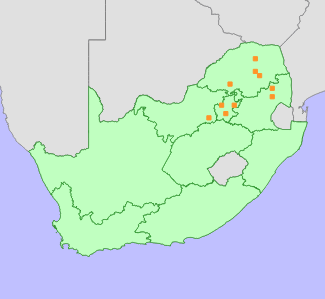|
Scientific Name | Brachystelma oianthum Schltr. |
Higher Classification | Dicotyledons |
Family | APOCYNACEAE |
National Status |
Status and Criteria | Least Concern |
Assessment Date | 2018/05/28 |
Assessor(s) | L. von Staden |
Justification | Brachystelma oianthum is a widespread species with an extent of occurrence (EOO) of 70 062 km² and is known from more than 10 locations. It is declining due to ongoing habitat loss, but is not yet in danger of extinction, and is therefore listed as Least Concern. |
Distribution |
Endemism | South African endemic |
Provincial distribution | Gauteng, Limpopo, Mpumalanga, North West |
Range | This species is endemic and widespread across the high-lying areas of northern South Africa. |
Habitat and Ecology |
Major system | Terrestrial |
Major habitats | Wolkberg Dolomite Grassland, Northern Escarpment Quartzite Sourveld, Carletonville Dolomite Grassland, Waterberg-Magaliesberg Summit Sourveld, Rand Highveld Grassland, Tsakane Clay Grassland, Soutpansberg Summit Sourveld, Woodbush Granite Grassland, Northern Escarpment Dolomite Grassland |
Description | It occurs in rocky outcrops in montane areas. |
Threats |
| Brachystelma oianthum has lost habitat to urban expansion in Gauteng and around Nelspruit. On the Limpopo and Mpumalanga Drakensberg Escarpment, it has declined due to habitat loss to timber plantations. About 40% of its habitat has been irreversibly modified, and loss continues. |
Population |
This is a rarely recorded species, and is known from scattered records. Plants are cryptic and easily overlooked when not in flower. It can be locally common in suitable habitat (Dyer 1983), but more often occurs as scattered individuals.
|
Population trend | Decreasing |
Assessment History |
Taxon assessed |
Status and Criteria |
Citation/Red List version | | Brachystelma oianthum Schltr. | Least Concern | Raimondo et al. (2009) | |
Bibliography |
Dyer, R.A. 1980. Brachystelma, Ceropegia and Riocreuxia. In: O.A. Leistner (ed). Flora of Southern Africa 27 Part 4:1-88. Botanical Research Institute, Pretoria.
Dyer, R.A. 1983. Ceropegia, Brachystelma and Riocreuxia in southern Africa. A.A. Balkema, Rotterdam, Netherlands.
Raimondo, D., von Staden, L., Foden, W., Victor, J.E., Helme, N.A., Turner, R.C., Kamundi, D.A. and Manyama, P.A. 2009. Red List of South African Plants. Strelitzia 25. South African National Biodiversity Institute, Pretoria.
|
Citation |
| von Staden, L. 2018. Brachystelma oianthum Schltr. National Assessment: Red List of South African Plants version 2024.1. Accessed on 2025/11/30 |
 Comment on this assessment
Comment on this assessment


